 W
WCastles in Turkey were built in the Ancient and Medieval Times. The Turkish names for castle are kale and hisar. Thus the names of some castles have -kale or -hisarı suffixes.
 W
WCastle of Afyonkarahisar is a historical fortification, which was built around 1350 BC and is located in Afyonkarahisar, Turkey.
 W
WAlanya Castle is a medieval castle in the southern Turkish city of Alanya.
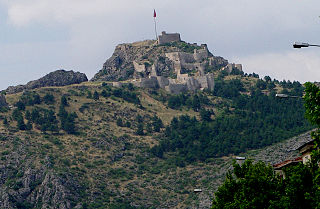 W
WAmasya Castle, a.k.a. Harşene Castle, is a fortress located in Amasya, northern Turkey.
 W
WThe castle of Amouda Crusader castle, formerly in the Armenian Kingdom of Cilicia, and today in the Turkish Province of Osmaniye. The castle was deeded by the Armenian king Levon I to the Teutonic Knights in 1212 and rebuilt by them in the 13th century. It earned revenue for the Teutonic Order from the surrounding land. According to contemporary sources, the castle provided shelter for 2,200 people during the invasion by the Mamluks in 1266.
 W
WAnvarza Castle is an ancient castle in Adana Province, Turkey.
 W
WAnkara Castle is a historic fortification in the city of Ankara in Turkey. It was founded in the 8th century BC by the Phrygians and rebuilt in 278 BC by the Galatians. The castle underwent several renovations during the Roman, Byzantine, Seljuk, and Ottoman eras.
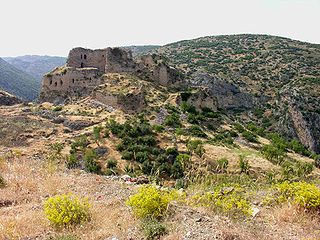 W
WBagras or Baghrās, ancient Pagrae, is a town and its nearby castle in the İskenderun district of Turkey, in the Amanus Mountains.
 W
WBodrum Castle is a historical fortification located in southwest Turkey in the port city of Bodrum, built from 1402 onwards, by the Knights of St John as the Castle of St. Peter or Petronium. A transnational effort, it has four towers known as the English, French, German, and Italian towers, bearing the names of the nations responsible for their construction. The castle was completed in the late 15th century, only to be taken over by the Islamic Ottoman Empire in 1523. The chapel was converted to a mosque, and a minaret was added. The castle remained under the empire for almost 400 years. After remaining empty following World War I, in the early 1960s, the castle became the home for the award-winning Bodrum Museum of Underwater Archaeology. In 2016 it was inscribed in the Tentative list of World Heritage Sites in Turkey.
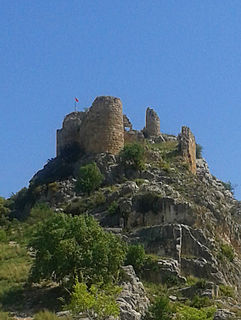 W
WBodrumkale is a castle ruin in Osmaniye Province, Turkey. It is situated on a hill at 37°10′39″N 36°11′15″E. Its distance to Osmaniye is about 12 kilometres (7.5 mi). The castle is to the northeast of the ancient city of Castabala. In medieval times it controlled the road from Central Anatolia to the Mediterranean coast. In 1973 an archaeological assessment and accurate plan were published. The castle is divided into two baileys or wards and has six towers. Most of its masonry was cut directly from the limestone outcrop and not plundered from the ancient city below. The lower level of the south tower functioned as a cistern. The survey was conducted under the auspices of the University of California at Berkeley.
 W
WThe Bolaman Castle is a historic castle located at Bolaman town of Fatsa in Ordu Province, Turkey.
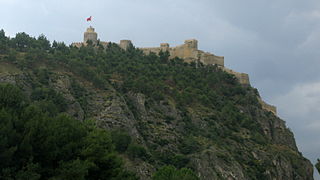 W
WBoyabat Castle, is a castle in the town of Boyabat, Sinop Province, Turkey built by the Paphlagonians in antiquity and reconstructed under Roman, Byzantine, and Ottoman rule. The castle functions as a museum today.
 W
WBozcaada Castle is a castle in the Turkish island of Bozcaada.
 W
WÇeşme Castle is a historic castle in Çeşme, Turkey.
 W
WDağlı Castle is a castle ruin in Mersin Province, Turkey
 W
WDiyarbakır Fortress, is a historical fortress in Sur, Diyarbakır, Turkey. It consists of an inner fortress and an outer fortress.
 W
WDüziçi is a town and district of Osmaniye Province in the Mediterranean region of Turkey. It is located in a small plain in the foothills of the Nur Mountains and 440 m above the sea level.
 W
WEğirdir Castle is a castle in Turkey
 W
WGaziantep Castle is a castle first built by the Hittite Empire as an observation point and later built into a main castle by the Roman Empire on top of a hill at the center of Gaziantep, Turkey, in 2nd and 3rd centuries AD. It underwent further expansion and renovation under Emperor Justinianus between 527 and 565 AD. The circumference of the round shaped castle is 1200 meters. The walls are built of stone and the castle consists of 12 towers.
 W
WGiresun Castle is a fortress built in the 2nd century BC in what is now Giresun Province, Turkey.
 W
WGözne Castle is a medieval castle in Mersin Province, Turkey.
 W
WGüvercinada is an island in western Turkey connected to mainland Kuşadası of Aydın Province via a relatively narrow, man-made causeway which is 350 m (1,150 ft) in length.
 W
WHarput Castle, also known as Milk Castle, is a castle located in the historical Harput neighborhood within the borders of the current Elazig province, Turkey. It was built by the Urartians on a rectangular plan. The castle consists of two parts, internal and external. According to legend, a scarcity of water and abundance of milk during its construction meant that milk was added to the castle's mortar, leading to it being sometimes called "Milk Castle".
 W
WKahramanmaraş Castle is a castle in Turkey. Kahramanmaraş is an old city.
 W
WKalepark was built by the Genoese and Venetian merchants as a medieval fortress on the east side of Trabzon, Turkey. The fortress was built on a rocky outcrop strategically overlooking both harbors of the city: the summer harbor at a distance to the west, and the winter harbor just to the east of it.
 W
WKaraman Castle is in the city of Karaman, Turkey.
 W
WKastamonu Castle is a medieval castle in Kastamonu, Turkey.
 W
WKayseri Castle, is a castle built in antiquity and first mentioned in a coin during the rule of Gordian III between 238 and 244 AD. It went through multiple additions starting with the Romans, continuing with the Byzantines, Danishmends, Seljuqs, Dulqadirs, Karamanids, and Ottomans. The castle, located in the eponymous city, is made of an inner and an outer section with a total of 18 towers.
 W
WKiz Kulesi is a medieval castle located on small islet, 1 km west of the center of Pazar, Rize Province, Turkey. According to A. Bryer it was built between 13th to 14th centuries, during the time of the Trebizond Empire. According to another sources castle was built by Genoese, as a summer residence for the daughter of a Genoese prince.
 W
WKızkalesi is a castle situated on a small island in Mersin Province of Turkey.
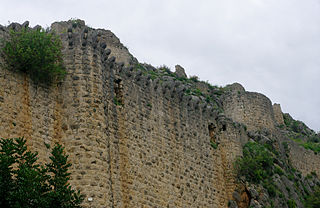 W
WKozan Castle is a castle in Kozan, Adana Province, Turkey.
 W
WMamure Castle is a medieval castle in the Anamur District of Mersin Province, Turkey.
 W
WMancınık Castle is a Hellenistic castle ruin in Mersin Province, Turkey.
 W
WMarmaris Castle is located in Muğla province, Turkey. The castle was reconstructed by Süleyman the Magnificent during his expedition against Rhodes.
 W
WPertek Castle is a castle in the Pertek district of the Tunceli province in Turkey.
 W
WQ'ueli or Q'uelis-tsikhe was a medieval Georgian fortress atop the homonymous mountain of the Arsiani Range, now within the boundaries of Turkey, where it is known as Kol Kalesi or Kuvel Kalesi. Its Georgian name is alternatively transliterated as Qveli, Kveli, K'veli, Qvelis-ts'ikhe or Qvelis-c'ixe. First appearing in the early 10th-century Georgian sources, Q'ueli was one of the principal fortifications of the province of Samtskhe until being conquered by the Ottoman Empire in the 16th century.
 W
WRize Castle is a partly-ruined medieval castle located in Rize, northeastern Turkey.
 W
WRumkale literally means "Roman Castle", was a powerful fortress on the river Euphrates, 50 km west of Şanlıurfa.
 W
WSamsun Castle was a castle in Samsun, Turkey. Built on the seaside in 1192, it was demolished between 1909 and 1918.
 W
WŞanlıurfa Castle, or Urfa Castle in short, is a castle overlooking the city center of Şanlıurfa, Turkey. The castle was built by the Osroene in antiquity and the current walls were constructed by the Abbasids in 814 AD. Today, the castle functions as an open-air museum.
 W
WSarvandikar, also spelled Sarvanda k'ar. It was the Frankish castle of Savranda and is officially known today as Savranda Kalesi. The site is a medieval castle in the former Armenian Kingdom of Cilicia, located in Turkey's Osmaniye Province approximately 115 kilometers east of Adana.
 W
WŞeytan Castle is a castle in the Çıldır district of the Ardahan Province in Turkey.
 W
WSilifke Castle is a medieval castle in Turkey.
 W
WSinap Castle is a medieval Armenian fortification in Çamlıyayla ilçe (district) of Mersin Province in southern Turkey.
 W
WSinop Fortress is a historic castle in Sinop, Turkey.
 W
WSofta Castle is a ruined castle in Bozyazı ilçe (district) of Mersin Province, Turkey.
 W
WTekkadın ruins are a group of ruins in Mersin Province, Turkey. The name of the ruins is a local name meaning "single woman". The original name is not known. The ruins are in the rural area of Silifke ilçe (district) of Mersin Province at 36°29′19″N 34°00′27″E. The visitors follow Turkish state highway D.400 and turn north in Atakent town. The ruins are about 11 kilometres (6.8 mi) to Atakent. Distance to Silifke is 27 kilometres (17 mi) and to Mersin is 77 kilometres (48 mi).
 W
WTokat Castle, is an ancient citadel with 28 towers built on top of a rocky peak in the center of Tokat, Turkey.
 W
WTrapessac is a medieval fortress located 4 km north of the town of Kırıkhan in Hatay Province, Turkey. Trapessac was constructed in the 12th century by the Knights Templar and, together with the nearby fortress at Bagras, guarded the Syrian Gates, the principal pass between the coastal region of Cilicia and inland Syria.
 W
WTushpa was the 9th-century BC capital of Urartu, later becoming known as Van which is derived from Biainili the native name of Urartu. The ancient ruins are located just west of Van and east of Lake Van in the Van Province of Turkey. In 2016 it was inscribed in the Tentative list of World Heritage Sites in Turkey.
 W
WThe Fortress of Van is a massive stone fortification built by the ancient kingdom of Urartu during the 9th to 7th centuries BC, and is the largest example of its kind. It overlooks the ruins of Tushpa the ancient Urartian capital during the 9th century which was centered upon the steep-sided bluff where the fortress now sits. A number of similar fortifications were built throughout the Urartian kingdom, usually cut into hillsides and outcrops in places where modern-day Armenia, Turkey and Iran meet. Successive groups such as the Medes, Achaemenids, Armenians, Parthians, Romans, Sassanid Persians, Byzantines, Arabs, Seljuks, Safavids, Afsharids, Ottomans and Russians each controlled the fortress at one time or another. The ancient fortress is located just west of Van and east of Lake Van in the Van Province of Turkey.
 W
WYılankale is a late 12th–13th century Armenian castle in Adana Province of Turkey. It is known in Armenian as Levonkla after its possible founder—King Leo (Levon) I the Magnificent of the Armenian Kingdom of Cilicia. Medieval Armenian names attached to the site are Kovara and Vaner.
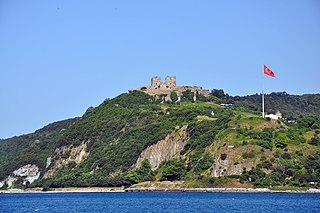 W
WYoros Castle is a Byzantine ruined castle at the confluence of the Bosphorus and the Black Sea, to the north of Joshua's Hill, in Istanbul, Turkey. It is also commonly referred to as the Genoese Castle, due to Genoa’s possession of it in the mid-15th century.
 W
WZilkale is a medieval castle located in the Fırtına Valley within the Pontic Mountains, and is one of the most important historical structures in the Çamlıhemşin district of Rize Province, within the Black Sea Region of Turkey.